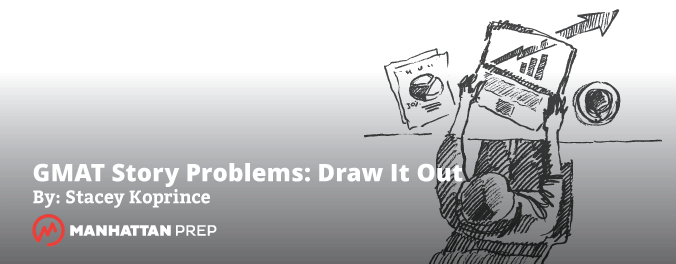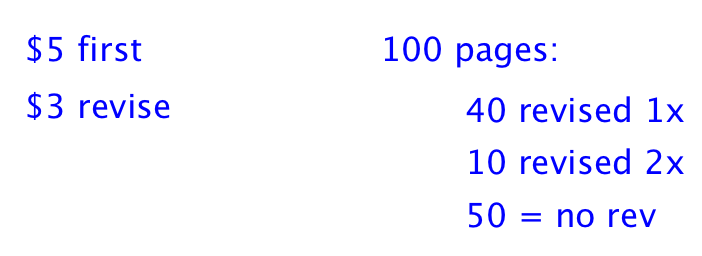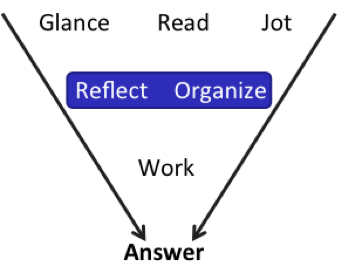 Whenever I see a story problem, I immediately make myself think, “How would I solve this in the real world?” I don’t want to get sucked into doing a bunch of annoying textbook math. In the real world, we lay things out on paper very differently than when we’re in “I’m taking a math test” mode.
Whenever I see a story problem, I immediately make myself think, “How would I solve this in the real world?” I don’t want to get sucked into doing a bunch of annoying textbook math. In the real world, we lay things out on paper very differently than when we’re in “I’m taking a math test” mode.
Want to see what I mean? Try this GMATPrep® problem from the free exams and then we’ll talk!
“*Rates for having a manuscript typed at a certain typing service are $5 per page for the first time a page is typed and $3 per page each time a page is revised. If a certain manuscript has 100 pages, of which 40 were revised only once, 10 were revised twice, and the rest required no revisions, what was the total cost of having the manuscript typed?
“(A) $430
“(B) $620
“(C) $650
“(D) $680
“(E) $770”
Got your answer? Okay, first, let’s understand what’s going on.
Glance: PS. Story problem. The answers are numeric and aren’t super easy but they aren’t too ugly, either.
Read: I’m trying to figure out how much it’s going to cost me to get my manuscript typed. (See what I did there? Real world.) There are various prices depending on the service required.
How should I approach this?
I could write out a formula here. But I really don’t want to. ![]()
In the real world, I’d just lay out each stage carefully and then add up my costs. So that’s exactly what I’m going to do here.
The correct answer is (D).
What could have been a somewhat annoying algebra problem turns into a fairly straightforward calculation. I don’t have to worry about making a mistake with setting up a formula. I just have to think carefully through what I’m actually going to have to pay for and make sure I write it all down.
There are different ways you could set this up. I chose to figure out how much I’d have to pay for the initial typing vs. the revisions. You could also calculate for the 40 / 10 / 50 numbers that I first wrote down, but be careful with the math to avoid trap answer (A):
40 typed = (40)(5) = 200, plus one revision = (40)(3) = 120. Total = 320
10 typed = (10)(5) = 50, plus two revisions = (10)(6) = 60. Total = 110
50 typed = (50)(5) = 250
Total = 320 + 110 + 250 = 680
What’s the trap for answer (A)? If you forget to add in the initial $5 per page for the set of 40 and the set of 10, you’ll get to answer (A), $430. Spot any other traps?
Trap answer (C) is the result of forgetting to double the revision cost for the 10 pages that get revised twice.
Key Takeaways for GMAT Story Problems:
(1) Pretend this is happening in the real world. How would you solve? I’m confident you wouldn’t start writing equations. Do the same back-of-the-envelope calculations you’d really do if you had to figure this out for yourself.
(2) Write all the steps down! Don’t skimp on this. Saving yourself 20 seconds by doing math in your head is a great way to make a careless mistake and lose a point that you knew how to get.
* GMATPrep® questions courtesy of the Graduate Management Admissions Council. Usage of this question does not imply endorsement by GMAC.
 Stacey Koprince is a Manhattan Prep instructor based in Montreal, Canada and Los Angeles, California. Stacey has been teaching the GMAT, GRE, and LSAT for more than 15 years and is one of the most well-known instructors in the industry. Stacey loves to teach and is absolutely fascinated by standardized tests. Check out Stacey’s upcoming GMAT courses here.
Stacey Koprince is a Manhattan Prep instructor based in Montreal, Canada and Los Angeles, California. Stacey has been teaching the GMAT, GRE, and LSAT for more than 15 years and is one of the most well-known instructors in the industry. Stacey loves to teach and is absolutely fascinated by standardized tests. Check out Stacey’s upcoming GMAT courses here.
The post GMAT Story Problems: Draw It Out appeared first on GMAT.



